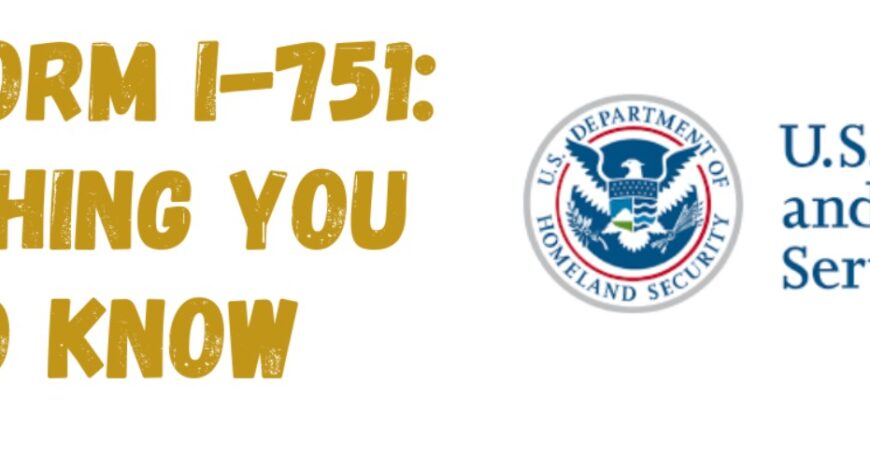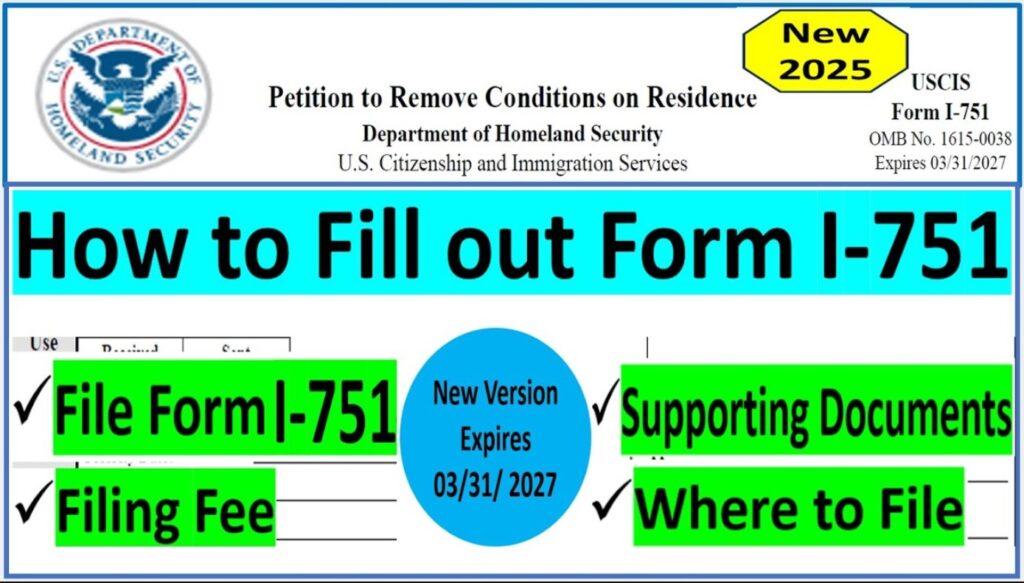All About the I-751 Form: Your Complete Guide to Filing, Fees, and Processing Time
The I-751 form is essential for any conditional resident looking to remove the conditions on their U.S. permanent residency. If you’re navigating the I-751 process, understanding the form’s details, filing instructions, and processing time can help you avoid mistakes and ensure everything is done correctly.
In this guide, we’ll dive into all aspects of the I-751 form, including the I-751 filing fee, the necessary documents, and what to expect in terms of processing time. Let’s walk through the steps you need to take to make your journey as smooth as possible!
What is the I-751 Form?
The I-751 form is a petition to remove the conditions on a person’s U.S. permanent residency.
If you were granted conditional residency through marriage to a U.S. citizen or permanent resident, you will need to file the I-751 form to prove that your marriage is bona fide (genuine) and not entered into solely for immigration purposes. This petition must be filed within the 90-day window before your two-year conditional green card expires.
It’s important to understand that filing the I-751 form is a key step in becoming a permanent resident of the United States.
Who Needs to File the I-751 Form?
If you received a conditional green card through marriage, you’ll likely need to file this form.
You’ll need to file if:
- Your green card was issued based on marriage to a U.S. citizen or permanent resident.
- You’ve been married for less than two years and received a conditional resident card.
- You are seeking to remove the conditions on your permanent resident status after two years.
How to File the I-751 Form
Step 1: Gather Your Documents
Before you begin filling out the I-751 form, ensure you have all the necessary documentation to prove that your marriage is real and ongoing. Here are the key documents you’ll need to submit:
- I-751 form (completed and signed).
- Proof of a bona fide marriage: Joint tax returns, bank account statements, utility bills, leases, etc.
- A copy of your conditional green card.
- Evidence of a valid marriage (photos, affidavits, and correspondence).
Step 2: Fill Out the Form
The I-751 form requires basic information about you, your spouse, and your marriage. Be honest and thorough when filling it out. Don’t leave any sections blank unless they specifically don’t apply to you.
Step 3: Submit the I-751 Form
Once the form is completed, you’ll submit it to the appropriate U.S. Citizenship and Immigration Services (USCIS) address, along with any supporting documents and the I-751 filing fee.
Pro tip: Ensure you are filing the form within the 90-day window before your conditional green card expires to avoid any delays.
I-751 Filing Fee
One of the most crucial things to remember is the I-751 filing fee. As of the most recent guidelines, the I-751 filing fee is $595, plus an additional $85 biometrics fee for applicants aged 14 through 78.
This fee is for the processing of your petition and any associated biometrics (fingerprinting). You must pay the entire fee at the time of submission, or your application may be delayed.
Can You Get a Fee Waiver?
Some applicants might qualify for a fee waiver if they can demonstrate financial hardship. Check the official USCIS guidelines to see if you qualify for a waiver before filing.
I-751 Processing Time
Once you file your I-751 form, you’ll want to know how long the I-751 processing time is. On average, I-751 processing time takes about 12 to 18 months.
However, this can vary depending on your specific case and the USCIS service center handling your petition. Be sure to track your petition’s status through the USCIS online portal for real-time updates.
What Happens After Filing?
After you file, you’ll receive a Notice of Action (Form I-797) from USCIS confirming that your I-751 form has been accepted. This notice extends the validity of your green card while your petition is being processed. If you’ve been married for less than two years, this is a temporary extension, and you’ll need to wait for a decision on your application.
Interviews and Requests for Evidence (RFEs)
In some cases, USCIS may request additional documentation or schedule an interview. Don’t worry if this happens—it’s a normal part of the process. Just ensure you provide any requested documents promptly to avoid delays.
Common Mistakes to Avoid When Filing the I-751 Form
Filing the I-751 form can be a complicated process, and there are several common mistakes applicants make. Here’s what to watch out for:
- Incomplete forms: Double-check that all sections are filled out correctly.
- Incorrect filing fee: Ensure you pay the correct I-751 filing fee and biometrics fee.
- Not providing enough evidence: Make sure you include sufficient proof that your marriage is legitimate.
What Happens After Your I-751 is Approved?
Once your I-751 form is approved, you’ll receive your permanent green card—the conditions will be removed, and you’ll be able to live and work freely in the U.S.
If Denied:
If your I-751 form is denied, don’t panic. You may appeal the decision or submit a new petition. Consulting with an immigration attorney is a good idea if this happens.
I-751 FAQs
What happens if I file the I-751 late?
If you miss the 90-day filing window, your green card could expire, leaving you without legal status. It’s crucial to file on time.
Can I file the I-751 on my own?
Yes, you can file the I-751 on your own without an attorney, but seeking legal counsel can make the process smoother, especially if your case is complex.
How long can I stay in the U.S. after filing the I-751?
Once you file, your green card is extended while your case is pending. You’re allowed to stay in the U.S. legally during this time.
Do I need an interview for the I-751?
Not everyone is required to attend an interview. However, USCIS may ask for one if they need additional information or clarification on your case.
Can I travel while my I-751 is being processed?
Yes, you can travel, but you should carry your receipt notice and any relevant documentation with you to avoid issues at customs.
Conclusion
Filing the I-751 form is crucial in maintaining your lawful permanent resident status. By understanding the requirements, filing the form on time, and paying the appropriate I-751 fee, you can ensure a smooth process and avoid unnecessary delays. Always refer to the I-751 instructions carefully, and don’t hesitate to seek professional help if needed.
By staying informed and prepared, you’ll increase your chances of success in removing the conditions on your green card and securing your permanent status in the U.S.
Key Tips for a Successful I-751 Application
Filing the I-751 form can be stressful, but with the right strategy, you can avoid unnecessary pitfalls. Here are some key tips to ensure your I-751 petition goes smoothly:
1. Keep Copies of Everything
Always make photocopies of every document you submit, including the I-751 form, any supporting documents, and your payment. This helps you keep track of what’s been submitted and provides a reference in case anything is misplaced.
2. Double-Check Your Documents
Before submitting your application, ensure all the documents are complete, up-to-date, and legible. USCIS tends to be strict about accepting documentation. If you have any doubts, consider getting professional help.
3. Don’t Miss the Filing Window
The I-751 filing window is crucial. You must submit your form during the 90 days before your conditional green card expires. Failing to meet this deadline can lead to significant delays, or worse, a gap in your status.
If you file too early, your petition may be rejected, and if you file too late, you risk your green card expiring.
4. Be Patient – It Takes Time
Although the I-751 processing time can vary, patience is essential. Processing times can sometimes take more than a year, so be prepared to wait. However, rest assured that as long as your I-751 is pending, you remain in legal status, and you’ll receive extensions for your conditional green card.
5. Keep Your Address Updated
If you move during the processing of your application, make sure to update your address with USCIS to avoid missing important notices. You can update your address online through the USCIS website.
What to Do If You Need Help Filing the I-751 Form?
While it’s entirely possible to file the I-751 form on your own, some situations might require professional assistance. If your case is complicated, you might want to consult an immigration attorney. Here are some reasons why you might consider professional help:
- 1) If you’re unsure about any part of the process: An attorney can walk you through the requirements and ensure everything is correct.
- 2) If you’ve received a Request for Evidence (RFE): In case USCIS asks for additional documentation, an attorney can help you submit the necessary paperwork.
- 3) If your marriage has ended: If you’re filing for a divorce but need to remove conditions on your green card, a lawyer can guide you through the process.
- 4) If you have a complicated immigration history: Any past violations or issues with your immigration status can complicate your application. In these cases, legal guidance is invaluable.
Hiring a lawyer may come with additional costs, but it can save time and reduce the stress of navigating the process on your own.
Stay Updated on USCIS Policy Changes
USCIS policies and procedures sometimes change, and these changes can impact the way you file your I-751 form.
It’s important to stay up-to-date on the latest USCIS guidelines and announcements. Regularly check their official website or subscribe to immigration law blogs and newsletters to keep informed.
Helpful Resources for I-751 Filers
- USCIS Official Website: Check the official site for updates, filing tips, and the latest processing times.
- Immigration Lawyers: Websites like the American Immigration Lawyers Association (AILA) can help you find a licensed attorney if needed.
- Online Forums and Communities: Websites like Reddit and VisaJourney have communities where individuals share their experiences and provide advice on the I-751 filing process.
I-751 Form Timeline Example
Understanding the typical timeline can help set expectations as you move forward with your application.
- Filing: Submit the I-751 form within 90 days before your conditional green card expires.
- Receipt Notice: Within a few weeks, you’ll receive a Notice of Action (Form I-797) confirming your submission.
- Biometrics Appointment: Expect to receive a biometrics appointment notice. It usually happens 3-6 weeks after your submission.
- Request for Evidence (RFE): In some cases, USCIS may send a request for additional documentation, which can add a few months to the timeline.
- Decision: After reviewing all your materials, USCIS will issue a decision. On average, this takes around 12-18 months.
- Green Card Issuance: If your I-751 is approved, you’ll receive a permanent green card, and your conditions will be removed.
Final Thoughts
Filing the I-751 form is crucial in securing your permanent residency status in the United States. Understanding the I-751 processing time, the filing fee, and the required documentation is vital to avoid mistakes and delays.
By following the I-751 instructions carefully and staying on top of deadlines, you can successfully remove the conditions on your green card and enjoy the benefits of permanent residency in the U.S. Whether you’re filing on your own or with the help of an immigration attorney, making sure your application is complete and accurate is key to a smooth process.
If you’re feeling overwhelmed by the process, remember that there are many resources available to guide you along the way. Stay patient, be thorough, and keep track of important dates, and you’ll be well on your way to success in removing the conditions on your permanent residency.
How Syed Professional Services Can Help You with the I-751 Form Process
Navigating the complexities of the I-751 form process can be overwhelming, but Syed Professional Services is here to make it easier for you. Whether you are filing on your own or need professional assistance, Syed Professional Services offers a range of expert services that can ensure a smooth and successful application. Below, we break down how our services can help you at every stage of the I-751 process.
Expert Guidance in Completing the I-751 Form
One of the most important parts of the I-751 filing process is filling out the form accurately and completely. A mistake on your I-751 form can lead to delays or even denial. That’s where Syed Professional Services comes in.
We can provide:
- Detailed instructions on how to fill out each section of the form.
- Tailored advice based on your specific situation, ensuring that you submit the correct information.
- Assistance in gathering the necessary supporting documents, such as evidence of a bona fide marriage.
Comprehensive Document Review
When filing the I-751 form, it’s crucial to submit the right supporting documents to prove the authenticity of your marriage. Syed Professional Services specializes in reviewing your documents to ensure that everything you submit is in order. This includes:
- Reviewing joint financial records, such as tax returns, bank statements, and leases.
- Ensure your evidence of relationship is complete, such as photos, affidavits, and communications.
- Checking that all documents meet USCIS standards, helping you avoid the common mistake of submitting incomplete or improperly formatted paperwork.
Timely Filing and Deadlines Management
The I-751 filing deadline is a critical factor that can impact your status. Filing late can cause your conditional residency status to expire, which may lead to complications in your immigration process. With Syed Professional Services, we ensure that:
- Your I-751 petition is submitted on time, within the required 90-day filing window.
- You receive timely reminders about important dates such as the filing deadline and biometrics appointments.
We also assist with tracking USCIS processing times and any status updates related to your case.
Help with the I-751 Filing Fee
The I-751 filing fee can be confusing for some applicants. Syed Professional Services can provide clarity on:
- The exact filing fee for your case.
- Guidance on how to pay the I-751 filing fee and the biometrics fee.
- Fee waiver information for those who may be eligible for financial assistance in paying the fee.
We ensure that you understand your financial obligations and help you avoid any errors that could lead to processing delays.
Biometrics Appointment Assistance
After submitting the I-751 form, you’ll likely be required to attend a biometrics appointment. Syed Professional Services can guide you through:
- What to expect during your biometrics appointment.
- What documents should to bring with you to the appointment.
- How to reschedule if necessary or handle any complications that arise with your biometrics processing.
Having the right support at this stage can prevent delays and confusion.
Request for Evidence (RFE) Response
Sometimes USCIS may send a Request for Evidence (RFE) if it needs additional documentation to process your application. If you receive an RFE, Syed Professional Services is here to help you:
- Understand the nature of the RFE and the documents requested.
- Organize and submit the necessary evidence promptly.
- Craft a professional response that meets USCIS requirements.
Handling an RFE can be challenging, but our team ensures you respond correctly and avoid the risk of a delay or denial.
Dealing with Complex Cases
In some cases, applicants may face unique challenges, such as divorce, marital separation, or previous immigration issues. If you’re in a complex situation, Syed Professional Services provides:
- Legal advice on how to navigate difficult circumstances, including when and how to file the I-751 if your marriage has ended.
- Guidance on filing without your spouse, if necessary.
- Professional consultation to handle situations like previous deportations, immigration violations, or prior denials.
We ensure that you have expert support to handle even the most complicated I-751 situations.
Post-Filing Support: Tracking and Status Updates
Once your I-751 form is submitted, you may feel anxious about the processing time and want to ensure that everything is on track. Syed Professional Services keeps you informed by:
- Tracking your case status via USCIS portals and notifications.
- Updating you on USCIS responses or changes in processing times.
- Helping you prepare for the next steps, whether it’s attending an interview, receiving an RFE, or waiting for a decision.
With our comprehensive post-filing support, you won’t be left in the dark at any stage of the process.
Why Choose Syed Professional Services?
- Expertise: Our team is well-versed in immigration law, ensuring that your I-751 petition is filed correctly and efficiently.
- Personalized Service: We tailor our services to meet your specific needs, ensuring you receive the best advice for your unique situation.
- Efficiency: We understand the urgency of the I-751 process and help you stay on track to avoid delays and complications.
- Support at Every Step: From filing the form to dealing with RFEs, we’re with you every step of the way.
If you’re ready to tackle your I-751 form with confidence, Syed Professional Services is here to assist. With our expert guidance, you can ensure that your application is filed correctly, efficiently, and on time, making your immigration journey smoother and less stressful.






